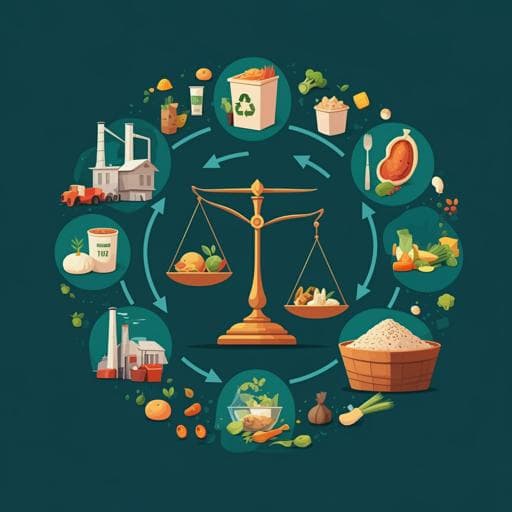
Food Science and Technology
A framework to quantify mass flow and assess food loss and waste in the US food supply chain
W. Dong, K. Armstrong, et al.
Explore the staggering findings of a study that estimates the food loss and waste along the US food supply chain, revealing that a whopping 335.4 million metric tonnes were lost in 2016 alone! This study, conducted by Wenquan Dong, Kristina Armstrong, Mingzhou Jin, Sachin Nimbalkar, Wei Guo, Jie Zhuang, and Joe Cresko, offers insights into improving supply chain efficiency and sustainability through better food donation practices.
~3 min • Beginner • English
Introduction
The study addresses the problem of substantial resource use and environmental burdens from the U.S. food system, where over one-third of produced food is not eaten, contributing significantly to land, water, energy use, and greenhouse gas emissions. Given a national goal to halve food loss and waste (FLW) to landfill and incineration by 2030, the research question is how much FLW is generated across the entire U.S. food supply chain (FSC), where it occurs by stage and commodity, and how it is managed through different pathways. The purpose is to establish a comprehensive, stage- and commodity-resolved mass flow baseline for 2016 that includes both edible and inedible fractions and tracks nine management pathways. This enables identification of hotspots and opportunities for reduction, recycling, and recovery, informing policies and practices to improve efficiency, sustainability, and food security.
Literature Review
Previous U.S. FLW studies vary widely in definitions, scope, data sources, and methods, leading to inconsistent estimates. Many focused only on downstream stages—warehouse/retail (W&R) and consumption—considering edible portions only and omitting FLW management pathways. Some studies applied waste factors to mass or business data for limited stages (on-farm, manufacturing, distribution) without clear scope regarding by-products, and often lacked validation against actual mass flows and did not quantify uncertainty. Tabled comparisons in the paper show gaps: exclusion of inedible portions, lack of management breakdowns, non-U.S.-specific factors, and incomplete stage coverage. This work responds by defining FLW consistently with EPA and the FLW Protocol, covering five FSC stages and ten commodity groups, including edible and inedible portions, and quantifying allocation across nine management pathways with uncertainty analysis.
Methodology
The authors conduct a national-scale Mass Flow Analysis (MFA) of the 2016 U.S. food supply chain across five stages: on-farm production, manufacturing, distribution, wholesale & retail (W&R), and consumption (food services and households). Food is defined as products intended for human consumption (excluding soda and alcoholic beverages). Ten commodity groups are analyzed: grain (incl. corn sweeteners), fruits, vegetables (incl. vegetable oil), sugar, oil, dairy (incl. dairy fats), meat & poultry (incl. animal fat), seafood, eggs, and nuts.
Scope and definitions: Stage-level FLW is defined as food (edible and inedible) intended for human consumption that leaves a stage’s boundary, regardless of destination (e.g., donation, animal feed). Donated food is counted as FLW at the donating stage but re-enters the FSC and is excluded from total FSC-level FLW to avoid double counting. Nine management pathways are tracked: donation; animal feed; composting; anaerobic digestion (AD); land application; biochemical/industrial processing; landfill; incineration; wastewater treatment. For reporting, pathways are grouped following EPA’s Food Recovery Hierarchy (with land application combined with composting; wastewater grouped with landfill/incineration).
Data sources and accounting: Mass flows (harvested, non-food uses, trade, stocks) are primarily from USDA Annual Agricultural Statistics and related datasets; consumer-stage data (Available Food, Consumer Weight, Food Consumed) are from USDA LAFA. Two calculation pathways are used depending on data availability: (a) for grains, fruits, vegetables, seafood, nuts, agricultural materials available for manufacturing are known; coefficients are applied to estimate inputs to manufacturing, with unsold FLW determined by difference; (b) for oil, sugar, meat & poultry, dairy, eggs, waste factors estimate unsold FLW and materials entering manufacturing. Manufacturing FLW equals inputs to manufacturing minus food manufactured; manufactured food is inferred from downstream distribution and trade balances. Distribution FLW is assumed at 5% of food entering W&R. Stage FLW at W&R and consumption are obtained by differences between adjacent stage flows.
FLW management allocation uses ratios from a recent EPA methodology with adjustments from pathway-specific datasets (donation, animal feed, composting, AD, wastewater), and treats water removed during certain manufacturing processes (drying, refining) as a separate FLW stream excluded from management allocation (since it is not disposed via those pathways).
Uncertainty: Coefficients are assigned uncertainty ranges via a pedigree matrix. Assuming uniform distributions, a Monte Carlo simulation (10,000 runs) provides 95% confidence intervals by stage and commodity. Tools: Excel for aggregation, R for visualization, Python for uncertainty simulation.
Key Findings
- Total stage-level FLW across five stages is 343.2 million metric tonnes (MMT) in 2016; after accounting for 7.8 MMT of donated food that re-enters and is consumed, total FSC-level FLW is 335.4 MMT.
- Composition: 19% (63.7 MMT) is mass lost as water via evaporation/processing in manufacturing; 55.3% (185.5 MMT) is recovered/recycled; 23.1% (77.3 MMT) goes to landfill, wastewater treatment, or incineration (LWI). Management of 8.9 MMT (2.7%) of animal-related on-farm FLW is unknown.
- Stage contributions and flows:
• On-farm: 888.7 MMT harvested; 40.8 MMT unharvested FLW; 315.9 MMT to non-food uses; 12.8 MMT unsold FLW; net exports 159.4 MMT; net stock increase 18.1 MMT. On-farm FLW totals 53.6 MMT (~16% of total FLW).
• Manufacturing: 412.1 MMT agricultural inputs (382.6 domestic + 29.5 imported) produce 203.6 MMT of food (11.2 MMT exported); manufacturing FLW is 208.5 MMT, of which 63.7 MMT is evaporated water and 144.8 MMT is subject to pathway allocation. Manufacturing accounts for 61% of stage-level FLW yet has high recycling rates.
• Distribution: 207.2 MMT into distribution; 10.4 MMT FLW (relatively efficient, likely due to logistics/cold chain).
• W&R: 196.9 MMT enter W&R; 21.3 MMT FLW.
• Consumption: 175.6 MMT reach consumption plus 7.8 MMT donated food; 133.9 MMT consumed (126.1 purchased + 7.8 donated); 49.4 MMT consumption FLW. Consumption generates 57% of FLW sent to LWI.
- Management pathways:
• Manufacturing FLW is predominantly recycled: 109.6 MMT (75.7%) to animal feed; 19.3 MMT (13.3%) to land application; only 4.1 MMT (2.8%) landfilled and 0.5 MMT (0.3%) incinerated.
• Distribution and W&R (using same factors): 45.1% of FLW recycled; 54.9% to LWI.
• Consumption: 88.7% (43.8 MMT) to LWI; 11.3% (5.6 MMT) recycled.
• Across the whole FSC: animal feed is the largest pathway (116.6 MMT; manufacturing contributes 109.6 MMT of this); composting/land application receive 22.7 MMT; other industrial uses 14.4 MMT; LWI 77.3 MMT. Donation is small: 8.1 MMT donated, of which 7.8 MMT are consumed and 0.4 MMT not consumed.
- Commodity insights:
• On-farm losses are small for animal products (e.g., M&P 2.3 MMT; seafood 0.6; eggs 1.7; dairy 4.3) but larger for crops (e.g., grains 25.9; vegetables 9.2). Loss factors: grains 5.6%, vegetables 16%, fruits 20% (relative to harvested materials).
• Manufacturing losses are high for some commodities: oil (81% FLW), dairy (57% FLW), sugar processing dominated by water evaporation (~86%). Largest contributors to manufacturing FLW: dairy (24.6%), sugar (22.7%), oil (22.6%); grains and vegetables each ~20%, fruits ~14%—driven by high demand.
• Later-stage FLW (distribution, W&R, consumption) is dominated by five perishable, high-demand groups: vegetables, fruits, dairy, grain products, and meat & poultry. Overall total FLW shares: dairy ~20%, grains 17.8%, vegetables 13.8%, fruits 7.1%, oil 16.2%, sugar 15.4%; other (nuts, seafood, eggs) ~2.7%.
- Uncertainty analysis shows estimates by stage and commodity fall within relatively narrow 95% confidence intervals; higher uncertainty appears for distribution-stage FLW and certain on-farm and manufacturing coefficients due to data limitations.
Discussion
The comprehensive MFA reveals that while manufacturing accounts for most stage-level FLW by mass, much of it is unavoidable (inedible fractions and process water) and is effectively recycled, primarily as animal feed, with minimal reliance on landfill or incineration. In contrast, later stages—especially consumption—send a large share of FLW to landfill, incineration, or wastewater, indicating significant potential for improvement.
Implications include prioritizing strategies that extend shelf-life (advanced packaging, smaller resealable units), clarify and standardize date labeling to reduce premature discard, and improve cold chain and storage across distribution and retail. However, behavioral factors limit the impact of labels and packaging alone; thus, consumer education is critical. On-farm, FLW arises from labor shortages, supply–demand mismatches, and capacity constraints; much of the produce is edible yet under-donated due to logistics costs. Policy levers—tax incentives, infrastructure funding for collection, storage, and transport—can increase donation and diversion to higher-value recovery pathways. Regulations and programs (e.g., California’s mandatory organics recycling; France’s ban on discarding unsold food) demonstrate mechanisms to redirect FLW from LWI to reuse, recycling, and recovery.
Overall, the findings support a circular economy approach that targets prevention upstream, increases donation where feasible, and expands access to recycling and industrial uses, thereby reducing environmental burdens and improving food security.
Conclusion
This work provides a consolidated, system-wide MFA of the 2016 U.S. food supply chain, quantifying stage- and commodity-specific FLW and its allocation across nine management pathways. It establishes a baseline showing large masses are recycled or recovered, yet substantial amounts still go to landfill, incineration, or wastewater, and food donation remains minimal.
Key contributions include: (1) a transparent framework integrating multiple datasets to reconcile mass flows across five FSC stages and 10 commodity groups; (2) explicit inclusion of inedible fractions and pathway allocations; and (3) uncertainty quantification. Policy and practice recommendations include incentivizing earlier and greater food donation (infrastructure and tax incentives), expanding access to composting, AD, and industrial uses, adopting and supporting advanced packaging and standardized date labeling, and consumer education to reduce downstream FLW. Future research should improve data for on-farm and distribution stages, distinguish food services from household flows, better characterize management at farms (especially animal-related FLW), and further disaggregate edible versus inedible fractions to refine prevention and donation potential.
Limitations
- Limited data for on-farm FLW magnitudes and management, particularly for animal-related on-farm FLW (assigned as unknown) and for specifying crop-based recycling channels.
- Distribution-stage FLW factors are sparse, leading to higher uncertainty; management factors do not distinguish between distribution and W&R (same factors applied).
- Difficulty separating flows between food services and households at the consumption stage using available datasets.
- Possible underestimation of weight reduction due to water evaporation during manufacturing of dried/refined products.
- Some coefficients and waste factors are not U.S.-specific for certain commodities/stages, increasing uncertainty.
- Use of commodity-group factors (e.g., for dried vegetables) rather than product-specific coefficients at manufacturing introduces additional uncertainty.
Related Publications
Explore these studies to deepen your understanding of the subject.







